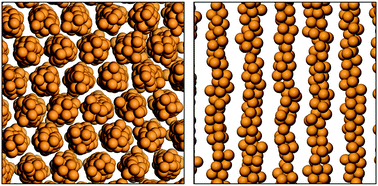Formation of a columnar liquid crystal in a simple one-component system of particles†
Abstract
We report a molecular dynamics simulation demonstrating that a columnar liquid crystal, commonly formed by disc-shaped molecules, can be formed by identical particles interacting via a spherically symmetric potential. Upon isochoric cooling from a low-density isotropic liquid state the simulated system underwent a weak first order phase transition which produced a liquid crystal phase composed of parallel particle columns arranged in a hexagonal pattern in the plane perpendicular to the column axis. The particles within columns formed a liquid structure and demonstrated a significant intracolumn diffusion. Further cooling resulted in another first-order transition whereby the column structure became periodically ordered in three dimensions transforming the liquid-crystal phase into a crystal. This result is the first observation of a columnar liquid crystal formation in a simple one-component system of particles. Its conceptual significance is in that it demonstrated that liquid crystals that have so far only been produced in systems of anisometric molecules can also be formed by mesoscopic soft-matter and colloidal systems of spherical particles with appropriately tuned interatomic potential.


 Please wait while we load your content...
Please wait while we load your content...